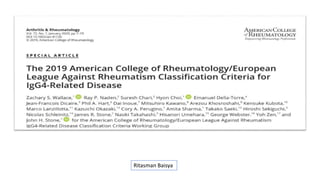
Presentation1.pptx
- 2. Introduction • Clinical, serologic, radiologic, and pathologic features all contribute to the classification of IgG4- RD • Proper categorization of patients for both research studies and clinical purposes relies upon integration of data from all domains of evidence • Classification criteria is needed for the conduct of high- quality clinical and epidemiologic investigations in this disease.
- 3. Entry criteria Exclusion criteria Inclusion criteria The 2019 American College of Rheumatology/European League Against Rheumatism Classification Criteria for IgG4- Related Disease
- 4. Exclusion criteria definitions Clinical and Lab – • Fever • No objective response to glucocorticoids • Leukopenia and thrombocytopenia without alternative explanation • Peripheral eosinophilia: To a concentration of >3,000 mm3 • Positive antineutrophil cytoplasmic antibody (ANCA • Positive antibodies • Cryoglobulinemia
- 5. Radiology exclusion • Suspicious for malignancy or infection that have not been investigated sufficiently - mass lesions that have not been evaluated thoroughly, necrosis, cavitation, hypervascular or exophytic mass, bulky or matted lymphadenopathy, loculated abdominopelvic fluid collection, among others. • Rapid radiologic progression: Defined as significant worsening within a 4–6- week interval. • Long bone abnormalities consistent with Erdheim-Chester disease • Splenomegaly: >14 cm
- 6. Pathologic exclusion • Cellular infiltrates suspicious for malignancy • Markers consistent with inflammatory myofibroblastic tumor • Prominent neutrophilic inflammation • fibrinoid necrosis within blood vessel walls • zonal necrosis with no alternative explanation (e.g., stenting) • Primary granulomatous inflammation: Inflammation rich in epithelioid histiocytes, including multinucleated giant cell formation and granuloma formation, • S100- positive macrophages demonstrating emperipolesis, a pathologic feature of Rosai- Dorfman disease.
- 7. Known diagnosis of the following • Multicentric Castleman’s disease • Crohn’s disease (if pancreatobiliary disease is present) • Ulcerative colitis (if pancreatobiliary disease is present) • Hashimoto thyroiditis (if the thyroid is the only proposed disease manifestation
- 9. The 2019 American College of Rheumatology/European League Against Rheumatism Classification Criteria for IgG4- Related Disease
- 11. Exclusion criteria contd ….
- 12. If case meets entry criteria and does not meet any exclusion criteria, proceed to step 3.
- 13. Step 3. Inclusion criteria: domains and items
- 14. Total point comes as 22
- 15. Performance of various thresholds of the 2019 American College of Rheumatology/European League Against Rheumatism classification criteria for IgG4- related disease using validation cohort
- 16. Important facts on 2019-ACR-EULAR classification criteria • The fact that the 2019 ACR/EULAR IgG4- RD classification criteria require neither a biopsy nor an elevated serum IgG4 level reflects important changes in the approaches whereby classifications of this disease are now assigned (and clinical diagnoses rendered) • Nearly 20% of cases classified as IgG4- RD had a normal serum IgG4 concentration or did not have a serum IgG4 value available. • 9% of the IgG4- RD cases did not have a biopsy, 37% lacked the classic histopathologic findings, and >40% did not meet previously defined cutoffs for IgG4+ plasma cell infiltrates
- 17. • The 2019 IgG4- RD classification criteria are one of the first sets of classification criteria in rheumatology to include absolute exclusion criteria that are not based solely on having an alternative diagnosis, but rather focus on clinical, serologic, radiologic, and pathologic features. • Sensitivity analysis indicated that in the absence of exclusion criteria, the specificity of the classification criteria decreased by nearly 10% Important facts on 2019-ACR-EULAR classification criteria
- 18. Limitation • Not included those organs that are involved only infrequently in IgG4- RD (e.g., patients with pituitary, breast, skin, or prostate disease).
- 19. Strengths • A cohort of nearly 1,900 patients with either IgG4- RD or a mimicking condition was assembled by an international group of investigators • Experts involved in the consensus exercises, decision analysis, and cohort development represented investigators from a variety of specialties (e.g., rheumatology, gastroenterology, pathology, and radiology) and from around the world, including the Americas, Europe, Asia, and Australia • Investigators involved in cohort development were not involved in other aspects of the classification criteria development, • Multicriteria decision analysis to derive the weights for each inclusion criteria item. These weights can be adjusted easily if or when other tests or information relevant to diagnosis become available
- 20. Thank You
